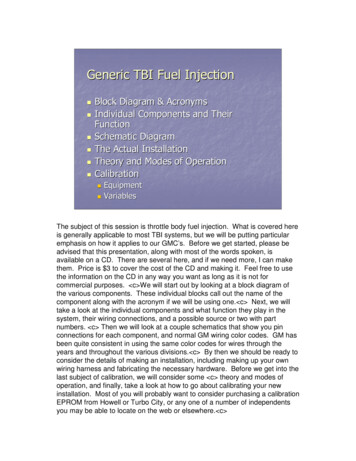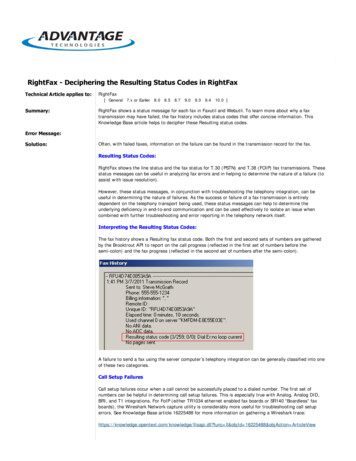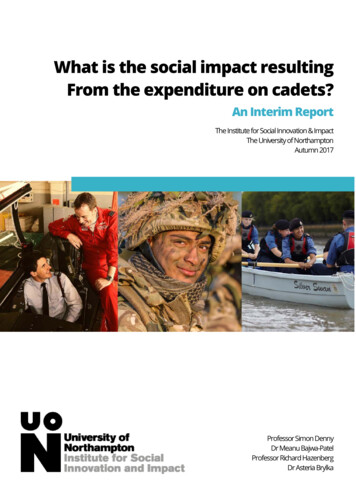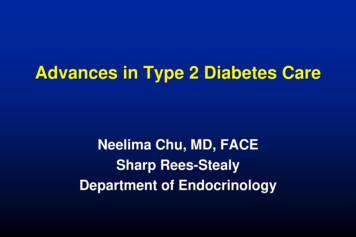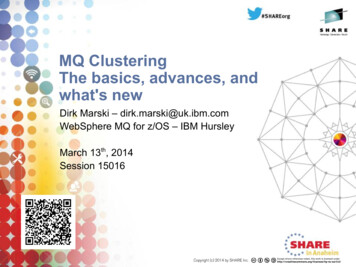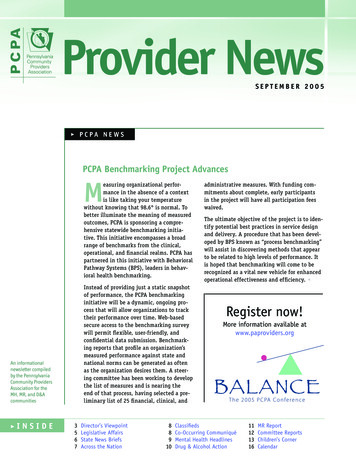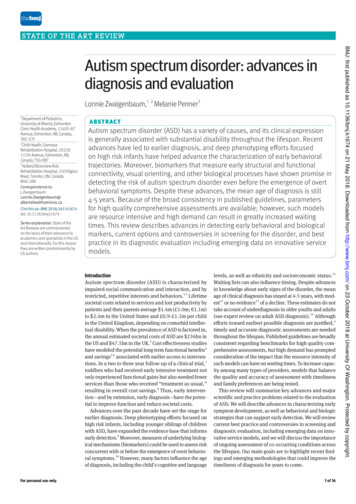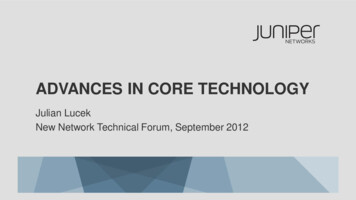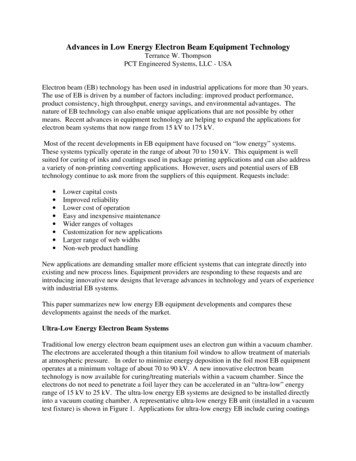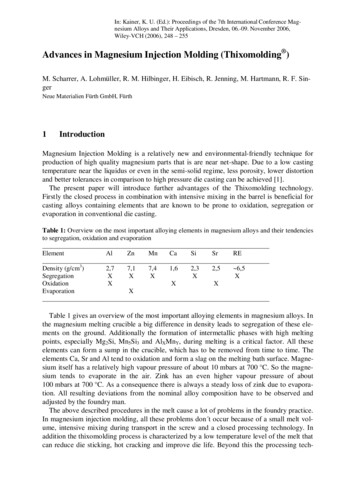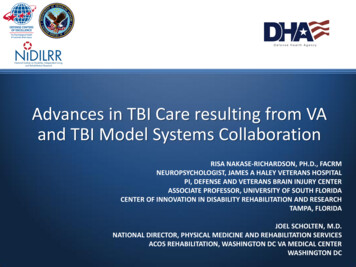
Transcription
Advances in TBI Care resulting from VAand TBI Model Systems CollaborationRISA NAKASE-RICHARDSON, PH.D., FACRMNEUROPSYCHOLOGIST, JAMES A HALEY VETERANS HOSPITALPI, DEFENSE AND VETERANS BRAIN INJURY CENTERASSOCIATE PROFESSOR, UNIVERSITY OF SOUTH FLORIDACENTER OF INNOVATION IN DISABILITY REHABILITATION AND RESEARCHTAMPA, FLORIDAJOEL SCHOLTEN, M.D.NATIONAL DIRECTOR, PHYSICAL MEDICINE AND REHABILITATION SERVICESACOS REHABILITATION, WASHINGTON DC VA MEDICAL CENTERWASHINGTON DC
Acknowledgements and Disclosures Financial Disclosures: None This research was sponsored by VHA Central Office VA TBI ModelSystems Program of Research; Subcontract from General DynamicsHealth Solutions (W91YTZ-13-C-0015) from the Defense andVeterans Brain Injury Center. This material is the result of work supported with resources andthe use of facilities in the Polytrauma Rehabilitation Centersincluding James A. Haley Veterans’ Hospital. The views, opinions, and/or findings contained in this article arethose of the authors and should not be construed as an officialposition by the Department of Defense, Department of VeteransAffairs, or any other federal agency, policy or decision unless sodesignated by other official documentation.
VA TBI Model System & I-MAP ResearchTeam and CollaboratorsTampa Polytrauma Rehabilitation CenterRisa Nakase-Richardson, Ph.D. – PI, IMAP PIMarc Silva, Ph.D.Leah Drasher-Phillips, MPHJill Massengale, DNP, ARNPAmanda Royer, B.S.- DVBICBridget Cotner, Ph.D. – QualitativeDanielle O’Connor, M.P.H – QualitativeMinneapolis Polytrauma Rehabilitation CenterGreg Lamberty, Ph.D. - PIJacob Finn, PH.D.Jillian Crocker – DVBICMichael Armstrong, M.D.San Antonio Polytrauma Rehabilitation CenterMary Jo Pugh, Ph.D.- PIMargaret Wells, B.S.Blessen Eapen, M.D.Kathleen Franklin, BSNBridget Miller, B.A. – DVBICJustin O’Rourke, Ph.D., ABPPRichmond Polytrauma Rehabilitation CenterLillian Stevens, Ph.D. - PIAngela Satariano, COTA- DVBICMandeesha Singh, B.A.Austin Smith, B.A. – DVBICPalo Alto Polytrauma Rehabilitation CenterSusan Ropacki, Ph.D. – PIOdette Harris, M.D.Karen Cullen, M.S.Jeff Teraoka, M.D.Nytzia Licona, MPH, CCTDM- DVBICVACO SupportLucille Beck, PhDDoug Bidelspach, MPTDavid Chandler ,PhDJoel Scholten, M.D.Linda Picon, MCD, CCC-SLPDave Cifu, M.D.IMAP Data and Statistical SupportXinyu Tang, Ph.D., Senior Biostatistician,Mimi Saylors, M.S., Biostatistician, University of Arkansas forMedical Sciences , Little Rock, ARAndrew Lapcevic, M.S., VACO TBIMS Data Center SupportTBIMS National Data and Statistical CenterDave Mellick, MS, National Data ManagerCindy Harrison-Felix, PH.D., Direction, National Data CenterKendy Noble, M.S., Senior Liaison and Quality SupportJessica Ketchum, Ph.D., Senior BiostatisticianWill Williams, M.S., Web Programmer3
What is the TBI Model System(TBIMS) Study? The National Institute on Disability, Independent Living and Rehabilitation Research(NIDILRR) TBI Model System (TBIMS) program, created in 1987 is a prospective,longitudinal, multi-center study which examines TBI recovery and outcomesfollowing coordinated acute medical care and inpatient rehabilitation.ooooo16 Funded Centers, 1 National Data Center, 1 Knowledge Translation Center 15,000 participants enrolledConducting 25-year post-injury follow-upsElaborate data collection policies, infrastructure, and quality guidelines, Twice Annual Meetings in DCSpecial Interest Groups (e.g., Sleep, PCORI, DOC, Aging), Committees (Research, Data, Knowledge Translation,Planning, Executive), and Modules. Goal: Conduct research that contributes to evidence-based rehabilitationinterventions and practice guidelines that improve the lives of individuals with TBI. VA TBIMS Primary Objective:oEstablish a longitudinal database of active duty military and veteran rehabilitation outcomesfrom TBI during acute and chronic stages of recovery.oData collection ensued in 4th quarter of 20094
Where are the 21 NIDILRR andVA TBIMS Sites?5
Variable Categorieswithin the VA TBIMSForm I – 398 VariablesForm II – 246 Variables(Pre-injury, Acute & Rehabilitation Care)(Post-Injury Annual Follow-Up: 1, 2, 5, 10 etc) DemographicsPremorbid FunctioningInjury Characteristics (mechanism andmultiple indices of severity)ComorbiditiesHospital CourseMortalityRehabilitation OutcomesLamberty GJ, Nakase-Richardson R, Farrell-Carnahan L, McGarity S,Bidelspach D, Harrison-Felix C, Cifu DX. Development of a TBI ModelSystems within the VA Polytrauma System of Care. J Head TraumaRehabil, 2014;29(3): E1-E7. Outcome– Mortality– Rehabilitation (FIM, DRS, GOS-E, Part-O)– Quality of Life (SWLS)– Health/Re-hospitalizationPsychological– PHQ-9, GAD-7, PCL-C, NSI– Substance Use– Treatment UtilizationUpdated Demographics (e.g., zip code)Socioeconomic– Income/Employment/School– Transportation6
TBIMS Progress Enrollment, N 1000Publications, N 19 (published, in press)Presentations, N 96Conference Awards, N 5– Most Early Career Mentees Informed Congressional Reports, N 2 Leveraged, New Funding 4
Leveraged FundingAward or Grant TitlePCORI – R1511-3305:Comparative Effectiveness of Sleep Apnea Assessment Strategies toMaximize TBI Rehabilitation Outcome(C-SAS)DVBIC-W91YTZ-13-C0015Improved Understanding of Medical And Psychological Needs(I-MAP) in Veterans and Service Members with Chronic TBIVA HSRD; SDR 13-228Veterans with mTBI: Barriers to Community ReintegrationVA RR&D; 1 I21RX001923-01A1Sleep-EEG Predictors of Functional Outcome after TBI
SEC. 721. LONGITUDINAL STUDY ONTRAUMATIC BRAIN INJURY(Mandated by Congress)Improved Understanding of Medical and Psychological Needs in Chronic TBIIMAP DURATION.—The study required by subsection (a) shall be conducted for aperiod of 15 years. (c) ELEMENTS.—The study required by subsection (a) shall specificallyaddress the following: (1) The long-term physical and mental health effects (2) The health care, mental health care, and rehabilitation needs afterthe completion of inpatient treatment (3) The type and availability of long-term care rehabilitation programsand services including community-based programs and services andin-home programs and services. (4) The effect on family members of a member incurring such an injury.9
I-MAP and the Relationship to theExisting TBIMSI-MAP is a 5-year, prospective, multi-center mixedmethods study which will capitalize on the existinginfrastructure of the VA TBI Model Systems Program.Phase 1: Analyze VA TBIMS to address military healthcareneeds–JHTR Special IssuePhase 2: Add new study measures to TBI Model Systeminfrastructure––––––NHANES ComorbidityRehabilitation Needs SurveyCraig Hospital Inventory of Environmental FactorsFamily Needs QuestionnairePatient Global Impression of ChangeHealthcare ServicesPhase 3: Qualitative data collection–Family and Veteran Perceived Rehabilitation Needs10
11
Recent studies highlight representativeness of theNIDILRR TBIMS to US population (age 18-61) receivinginpatient rehabilitation TBI Rehabilitation research informed by NIDLRR TBIMSstudies ( 830 to date) Compare demographic, injury, and outcomes acrossNIDILRR and VA TBIMS Cohorts at Enrollment (Rehab)
Differences inInclusion/Exclusion CriteriaTable 1. Summary of Inclusion and Exclusion criteria for NIDILRR and VA. TBIMSNIDILRRVAInclusionModerate to Severe TBIAny severity levelExclusion 16 years 18 yearsPresented to the TBIMS centerwithin 72-hours of injuryReceived both acute care andinpatient rehabilitation at theTBIMS centerNo time constraints to PRCpresentationPresented to a VA PRC forcomprehensive inpatient TBIrehabilitation72-hour or greater absence from Already being enrolled in TBIMSthe TBIMS center prior torehabilitation admissionIn law enforcement custody
VA Sample, N 550NIDILRR Sample, N 5270NIDILRRenrollmentVAenrollment
Etiology Comparison
Magnitude of Differences RatingsBased on Group Mean DifferenceRatingContinuous DataCategorical DataInsignificant(None)Minimal (Minor) 25% of 1 SD 5%of civilian25-49.99% of 1 SD 5-9.99%Important (Imp) 50% of 1 SD 10%Corrigan JD, Cuthbert JP, Whiteneck GG, Dijkers MP, Coronado V,Heinemann AW, Harrison-Felix C, Graham JE. Representativeness of thetraumatic brain injury model systems national database. J HeadTrauma Rehabil 2012, 27:391-403.
Number of Different RatingsAmong Comparisons Made Magnitude of differences varied by mechanismof injuryGroup% DifferentImpMinorOverall76%N 18N 8MVC74%N 15N 10Fall74%N 21N 4Violence76%N 22N 4
Demographic DifferencesDemographicsAge (Years)Gender: MaleRace / EthnicityWhiteBlack or African AmericanHispanicOtherMarital Status: MarriedEducation Categories High school diplomaHigh school diploma High school diplomaSignificance RatingFull Imp-CNoneNoneImp-CImp-VImp-V
Premorbid StatusPre-Morbid StatusFull Imp-VRetired (Age or Imp-CServed in the MilitaryImp-VImp-VImp-VImp-VYears in Active OtherDeployed in Combat Zone*
Pre-Injury Behavioral Health StatusBehavioral HealthFullSampleMVCFallViolentMental Health Utilization: EverImp-VImp-VImp-VNoneMinor-CMinor-C NoneImp-CAbstaining/LightNoneMinor-C NoneImp-CUse of Illicit/Non-Prescription DrugsDrinking Category
Injury CharacteristicsInjury CharacteristicsGCS, quartilesTime to Follow Commands, DaysFull Sample neDuration of PTA, DaysImp-VImp-V Minor-CNoneDuration of PTA, Days (censored)NoneNoneMinor-CMinor-CTSI to Inpatient Rehab, DaysImp-VImp-VImp-CImp-C
Conclusions Different mechanisms of injury across cohorts– Important from a prognosis standpoint in predicting outcome Important and minor differences varied across etiologies across mostcomparisons These differences may contribute to different outcomes across cohorts 13% (N 639)of NIDILRR participants were Veterans (underestimate) givinga more comprehensive review of Veterans using civilian healthcare Foundational base for evaluating generalizability of scientific findingsacross cohorts
VA TBIMS HealthOutcome Papers Tran J, Hammond F, Dams-O’Connor K, Tang X, Eapen B, McCarthy M, NakaseRichardson R. Rehospitalization in the First Year following Veteran and ServiceMember TBI: A VA TBI Model Systems Study. J Head Trauma Rehabil, 2017; 32(4): 264270. Holcomb EM, Schwartz DJ, McCarthy M, Thomas B, Barnett SD, Nakase-Richardson R.Incidence, characterization, and predictors of sleep apnea in consecutive brain injuryrehabilitation admissions. J Head Trauma Rehabil. 2016;31(2):82-100. Farrell-Carnahan L, Barnett S, Lamberty G, Hammond F, Kretzmer TS, Franke LM, GeissM, Howe L, Nakase-Richardson, R. Insomnia symptoms and behavioral health symptomsin veterans 1 year after traumatic brain injury. Brain Inj. 2015;29(12):1400-8. Towns SJ, Zeitzer J, Kamper J, Holcomb E, Silva MA, Schwartz DJ, Nakase-Richardson R.Implementation of actigraphy in acute traumatic brain injury neurorehabilitationadmissions: A veterans administration TBI model systems feasibility study. Phys MedRehabil. 2016;8(11):1046-1054.
Psychological Health Outcomes Gause LR, Finn JA, Lamberty GJ, Tang X, Stevens LF, Eapen BC, Nakase-Richardson R. Predictors ofsatisfaction with life in Veterans after traumatic brain injury: A VA TBI Model System study. J HeadTrauma Rehabil, 2017; 32(4): 255-263. Belanger HG, Silva MA, Donnell AJ, Mckenzie-Hartman T, Lamberty GJ, Vanderploeg RD. Utility of theNeurobehavioral Symptom Inventory as an outcome measure: A VA TBI Model Systems Study. J HeadTrauma Rehabil. 2017; 32(1):46-54.Under Review Finn JA, Lamberty GJ, Stevens L, Kretzmer T, Brenner L. Post-rehabilitation mental health treatmentseeking in veterans with traumatic brain injury: A VA TBI Model Systems study. J Head Trauma Rehabil,Accepted pending minor revisions Dreer LE, Tang X, Zafonte R, Nakase-Richardson R, Cox MK, Finn J, Pugh MJ, Bailey E. Suicide andtraumatic brain injury: a review by clinical researchers from the National Institute for Disability andIndependent Living Rehabilitation Research (NIDILRR) and Veterans Health Administration TraumaticBrain Injury Model Systems. Curr Opin Psychol. Under Review
First study of rehospitalization among a Veteran and Active Duty sample with TBI.Among 401 individuals readmitted with TBI, 164 (41%) were re-hospitalized by one year follow-up. This ishigher than the civilian TBIMS study samples (i.e., 28%) despite being a younger cohort. Of those rehospitalized:– 70% of patients were rehospitalized once– 17% of patients were rehospitalized twice– 13% of patients were rehospitalized three or more times– Reasons for re-hospitalization differ than civilian TBIMS studies Individuals with at least one re-hospitalization had greater severity of TBI and (significantly longer PTA andcoma duration) and were more likely to be active duty compared to those not re-hospitalized. Multiple re-hospitalizations were associated with deployment TBI and greater severity. Military factors associated with re-hospitalization. Recognizing the frequency and types of re-hospitalizations in this population may allow for increasedmonitoring, education, and preventative care to reduce morbidity and long-term healthcare costs.
Caregiver and familyfocused Stevens LF, Lapis Y, Tang X, Sander AM, Dreer LE, Hammond FM, Kreutzer J,O’Neil-Pirozzi TM, Nakase-Richardson R. Relationship stability after traumaticbrain injury among veterans and service members: A VA TBI Model Systemsstudy. J Head Trauma Rehabil, 2017; 32(4): 234-244. Bailey, EK, Nakase-Richardson R, Patel N, Dillahunt-Aspillaga C, Ropacki S, SanderAM, Stevens L, Tang X. Supervision needs following moderate to severe Veteranand Service Member Traumatic Brain Injury: A VA TBIMS Study. J Head TraumaRehabil, 2017; 32(4): 245-254. doi: 10.1097/HTR.0000000000000317. PMID:28520667. Nakase-Richardson R & Stevens LF. Informing the Needs of Veterans and ServiceMembers with TBI and Their Families: Leveraging the VA TBI Model SystemProgram of Research. J Head Trauma Rehabil, 2017; 32(4): 215-218.
What is supervision needs?–––Monitoring for safety due to physical, cognitive, behavioral impairmentsOptimally, it decreases over time as TBI sequelae improvesMeasured by the Supervision Rating Scale in TBIMS Previously, no studies of incidence in the literature in Veteran TBI sample Civilian TBIMS samples report up to 30% requires supervision at 1 year with ongoing needs persisting at 5years reported. Among 302 TBIMS Veterans and Service Members with moderate to severe TBI whohad a 1-year follow-up, 107 (35%) still had supervision needs Greater injury severity, lower functional independence, and being married were predictors of supervisionneed in univariate modelsInjury severity (i.e., duration of PTA) only predicted supervision needs in multivariate modeling Resources and services needs should continue to be available for Veterans and Service membersthrough one-year post-TBI in order to reduce the burden on caregivers.
What is supervision needs?– Monitoring for safety due to physical, cognitive, and behavioral impairments– Optimally, it decreases over time as TBI sequelae improves– Measured by the Supervision Rating Scale in TBIMS1 Civilian TBIMS samples report up to 30%2 requires supervision at 1 year withhigher percentages among DOC3 survivors. Ongoing needs persisting at 5-yearspost-injury3-4 have been reported. Previously, no studies of incidence in the literature in Veteran TBI sample Among 302 TBIMS Veterans and Service Members with moderate to severe TBIwho had a 1-year follow-up, 107 (35%) still had supervision needs1. Boake C. Supervision rating scale: a measure of functional outcome from brain injury. Arch Phys Med Rehabil. 1996; 77(8):765-772.2. Hart T, Millis S, Novack T et al., The relationship between neuropsychologic functioning and level of caregiver supervision at 1 year after TBI.Arch Phys Med Rehabil. 2003;84(2):221-30. 3. Nakase-richadson R, Whyte J, Giacino JT et al. Longitudinal outcome of patients with disorders ofconsciousness in the NIDIRR TBIMS. J Neurotrauma. 2012. 29(1):59-65. 4. Corrigan JD, Smith-Knapp K, Granger CV. Outcomes in the first 5years after traumatic brain injury. Arch Phys Med Rehabil. 1998:79(3):298-305.
Relationship status was mostly stable up to 2 years post-injury:– 78% of those married at enrollment remained married at 2 year follow-up– 87% of those divorced/separated/single remained so at 2 year follow-up Predictors of negative change among married individuals:– Younger age at injury– Lower education at injury– Mental health utilization prior to injury Predictors of positive change among single/divorced/separated:– Injury during deployment Characteristics may serve as triggers for prioritizing relationship-focusedcounseling post-injury34
Community Reintegration D’illahunt-Aspillaga C, Nakase-Richardson R, Hart T, Powell-Cope G, Dreer LE,Eapen BC, Barnett SD, Mellick DA, Haskin A, Silva MA. Predictors of employmentoutcomes in Veterans with traumatic brain injury: A VA TBI model system study. JHead Trauma and Rehabil. 2017; 32(4): 271-282. D’illahunt-Aspillaga C, Pugh M, Cotner B, Silva M, Haskin A, Tang X, Saylors M,Nakase-Richardson R. Employment Stability in Veterans and Service Memberswith Traumatic Brain Injury: A VA Traumatic Brain Injury Model Systems Study. ArchPhys Med Rehabil, 2017; 32(4): 271-282. McGarity S, Barnett S, Lamberty G, Kretzmer T, Powell-Cope G., Patel N., NakaseRichardson R. A comparison of community reintegration problems among veteransand active duty service members with mild and moderate to severe traumaticbrain injury. J Head Trauma Rehabil. 2016;32(1):34-45. doi:10.1097/HTR.0000000000000242. PMID: 27323217
Implications for VA Re-hospitalization– How can post-discharge surveillance affect healthstatus and healthcare utilization? Supervision Needs & Relationship Stability– What supports can VA provide to support caregivers inthe home setting to maximize independence andquality of life? Community Reintegration– What can VA do to enhance vocational rehabilitationefforts?
Impact Development of a Veteran-specific databaseallows for determination of unique Veteran needspost TBI and benchmarks VA care against worldclass TBI rehabilitation facilities Veteran specific studies inform and guide VApolicy The TBIMS critical research infrastructurepromotes collaboration with other agencies andfosters application for additional grant funding VA TBI staff collaborate with TBIMS expertsresulting in enhanced Veteran care and research
Contact InformationInformational Resources for TBMSWebsiteVA TBI Model Systems Online Syllabusva.tbindsc.orgNIDILRR TBI Model Systemswww.tbindsc.orgNIDILRR Model Systems KnowledgeTranslation Center (TBI, Burn, en@va.gov
the use of facilities in the Polytrauma Rehabilitation Centers including James A. Haley Veterans’ Hospital. The views
